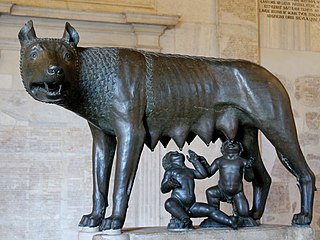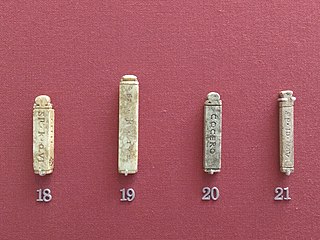Related Research Articles

The Gracchi brothers were two brothers who lived during the beginning of the late Roman Republic: Tiberius Gracchus and Gaius Gracchus. They served in the plebeian tribunates of 133 BC and 122–121 BC, respectively. They have been received as well-born and eloquent advocates for social reform who were both killed by a reactionary political system; their terms in the tribunate precipitated a series of domestic crises which are viewed as unsettling the Roman Republic and contributing to its collapse.

Marcus Opellius Macrinus was Roman emperor from April 217 to June 218, reigning jointly with his young son Diadumenianus. As a member of the equestrian class, he became the first emperor who did not hail from the senatorial class and also the first emperor who never visited Rome during his reign. Before becoming emperor, Macrinus served under Emperor Caracalla as a praetorian prefect and dealt with Rome's civil affairs. He later conspired against Caracalla and had him murdered in a bid to protect his own life, succeeding him as emperor.

The Roman Empire was the post-Republican state of ancient Rome. It is generally understood to mean the period and territory ruled by the Romans following Octavian's assumption of sole rule under the Principate in 27 BC. It included territories in Europe, North Africa, and Western Asia and was ruled by emperors. The fall of the Western Roman Empire in 476 AD conventionally marks the end of classical antiquity and the beginning of the Middle Ages.

The Roman Republic was the era of classical Roman civilization beginning with the overthrow of the Roman Kingdom and ending in 27 BC with the establishment of the Roman Empire following the War of Actium. During this period, Rome's control expanded from the city's immediate surroundings to hegemony over the entire Mediterranean world.

The patricians were originally a group of ruling class families in ancient Rome. The distinction was highly significant in the Roman Kingdom and the early Republic, but its relevance waned after the Conflict of the Orders. By the time of the late Republic and Empire, membership in the patriciate was of only nominal significance. The social structure of ancient Rome revolved around the distinction between the patricians and the plebeians. The status of patricians gave them more political power than the plebeians, but the relationship between the groups eventually caused the Conflict of the Orders. This time period resulted in changing of the social structure of ancient Rome.

The toga, a distinctive garment of ancient Rome, was a roughly semicircular cloth, between 12 and 20 feet in length, draped over the shoulders and around the body. It was usually woven from white wool, and was worn over a tunic. In Roman historical tradition, it is said to have been the favored dress of Romulus, Rome's founder; it was also thought to have originally been worn by both sexes, and by the citizen-military. As Roman women gradually adopted the stola, the toga was recognized as formal wear for male Roman citizens. Women found guilty of adultery and women engaged in prostitution might have provided the main exceptions to this rule.

In ancient Rome, the plebeians or plebs were the general body of free Roman citizens who were not patricians, as determined by the census, or in other words "commoners". Both classes were hereditary.

The Samnites were an ancient Italic people who lived in Samnium, which is located in modern inland Abruzzo, Molise, and Campania in south-central Italy.

In modern historiography, ancient Rome encompasses the founding of the Italian city of Rome in the 8th century BC, the Roman Kingdom, Roman Republic, Roman Empire, and the collapse of the Western Roman Empire in the 5th century AD.

The practices of ancient Roman finance, while originally rooted in Greek models, evolved in the second century BC with the expansion of Roman monetization. Roman elites engaged in private lending for various purposes, and various banking models arose to serve different lending needs.

Social class in ancient Rome was hierarchical, with multiple and overlapping social hierarchies. An individual's relative position in one might be higher or lower than in another, which complicated the social composition of Rome.
The term accensi is applied to two different groups. Originally, the accensi were light infantry in the armies of the early Roman Republic. They were the poorest men in the legion, and could not afford much equipment. They did not wear armour or carry shields, and their usual position was part of the third battle line. They fought in a loose formation, supporting the heavier troops. They were eventually phased out by the time of Second Punic War. In the later Roman Republic the term was used for civil servants who assisted the elected magistrates, particularly in the courts, where they acted as ushers and clerks.

Triarii were one of the elements of the early Roman military manipular legions of the early Roman Republic. They were the oldest and among the wealthiest men in the army and could afford high quality equipment. They wore heavy metal armor and carried large shields, their usual position being the third battle line. They were equipped with spears and were considered to be elite soldiers among the legion.
A commoner, also known as the common man, commoners, the common people or the masses, was in earlier use an ordinary person in a community or nation who did not have any significant social status, especially a member of neither royalty, nobility, nor any part of the aristocracy. Depending on culture and period, other elevated persons may have had higher social status in their own right, or were regarded as commoners if lacking an aristocratic background.

During the Roman Republic, there were watchmen that served as firefighters. They used water buckets to put out fires and axes to tear down buildings near the fire in order to prevent the fire from spreading. The aediles and tresviri nocturni were also employed to fight fires. Roman Emperor Augustus created the Vigiles. The Vigiles were an organization of freedmen that fought fires. They would use buckets and water pumps. Emperor Nero also created "bucket brigades" to help fight fires.

Freedmen in ancient Rome existed as a distinct social class (liberti or libertini), with former slaves granted freedom and rights through the legal process of manumission. The Roman practice of slavery utilized slaves for both production and domestic labour, overseen by their wealthy masters. Urban and domestic slaves especially could achieve high levels of education, acting as agents and representatives of their masters' affairs and finances. Within Roman law there was a set of practices for freeing trusted slaves, granting them a limited form of Roman citizenship or Latin rights. These freed slaves were known in Latin as liberti (freedmen), and formed a class set apart from freeborn Romans. While freedmen were barred from some forms of social mobility in Roman society, many achieved high levels of wealth and status. Liberti were an important part of the "most economically active and innovative entrepreneurial class" in the Roman Empire. The legal and social status of freedmen remained a point of cultural and legal contention throughout the Republic and Empire.
There were four primary kinds of taxation in ancient Rome: a cattle tax, a land tax, customs, and a tax on the profits of any profession. These taxes were typically collected by local aristocrats. The Roman state would set a fixed amount of money each region needed to provide in taxes, and the local officials would decide who paid the taxes and how much they paid. Once collected the taxes would be used to fund the military, create public works, establish trade networks, stimulate the economy, and to fund the cursus publicum.
In ancient Rome there were a variety of officials tasked with banking. These were the argentarii, mensarii, coactores, and nummulari. The argentarii were money changers. The role of the mensarii was to help people through economic hardships, the coactores were hired to collect money and give it to their employer, and the nummulari minted and tested currency. They offered credit systems and loans. Between 260 and the fourth century CE, Roman bankers disappear from the historical record, likely because of economic difficulties caused by the debasement of the currency.
Modern scholars of ancient Rome have found difficulty in defining who was considered to be living in poverty due to their lack of significant coverage in the historical record, and the difficulty in defining the lines between poverty and middle class. Roman writers describe the poorer parts of the population as unvirtuous and immoral masses who were threats to the nation and unconcerned with the values of the Roman world. Ancient Roman Christian depictions tend to depict the poor as more sympathetic and often call for the wealthy to help them. There were other efforts to help the poor, such as the Cura Annonae, a policy which redistributed grain. The Roman poor also had limited rights. They were unable to access political offices, had higher tax rates, and were unable to afford most status symbols.
Art collection in ancient Rome was a common practice amongst the ancient Romans. Goods and artworks had symbolic meanings and were used to convey messages about the collector and the Roman state. Due to the popularity of collectable goods an art market sprouted up. These goods were managed at first by the aediles and censors, and later by the curatores aedium sacrarum et operum locorumque. Lists may also have been used to track goods.
References
- ↑ Dillon, Matthew; Garland, Lynda (2013-10-28). Ancient Rome: A Sourcebook. Routledge. p. 242. ISBN 978-1-136-76143-0.
- ↑ Phang, Sara Elise (2022-03-31). Daily Life of Women in Ancient Rome. ABC-CLIO. pp. 3–4. ISBN 978-1-4408-7169-6.
- ↑ Oakes, Peter (2009). Reading Romans in Pompeii. Fortress Press. pp. 54–57. ISBN 978-1-4514-1593-3.
- ↑ Mongstad-Kvammen, Ingeborg (2013-01-01), "Social and Cultural Texture: A Short Overview of Roman Political History and Markers of Social Affiliation", Toward a Postcolonial Reading of the Epistle of James, Brill, pp. 75–76, ISBN 978-90-04-25187-8 , retrieved 2023-12-05
- ↑ Livy (2013-04-04). Rome's Italian Wars: Books 6-10. OUP Oxford. pp. 3–4. ISBN 978-0-19-164083-4.